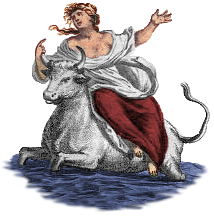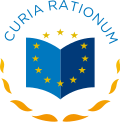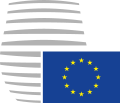Portal:European Union
Introduction
The European Union (EU) is a supranational political and economic union of 27 member states that are located primarily in Europe. The union has a total area of 4,233,255 km2 (1,634,469 sq mi) and an estimated population of over 449 million as of 2024. The EU is often described as a sui generis political entity combining characteristics of both a federation and a confederation. Containing 5.5% of the world population in 2023, EU member states generated a nominal gross domestic product (GDP) of around €17.935 trillion in 2024, accounting for approximately one sixth of global economic output. Its cornerstone, the Customs Union, paved the way to establishing an internal single market based on standardised legal framework and legislation that applies in all member states in those matters, and only those matters, where the states have agreed to act as one. EU policies aim to ensure the free movement of people, goods, services and capital within the internal market; enact legislation in justice and home affairs; and maintain common policies on trade, agriculture, fisheries and regional development. Passport controls have been abolished for travel within the Schengen Area. The eurozone is a group composed of the 20 EU member states that have fully implemented the EU's economic and monetary union and use the euro currency. Through the Common Foreign and Security Policy, the union has developed a role in external relations and defence. It maintains permanent diplomatic missions throughout the world and represents itself at the United Nations, the World Trade Organization, the G7 and the G20. Due to its global influence, the European Union has been described by some scholars as an emerging superpower.[needs update] In 2012, the EU was awarded the Nobel Peace Prize. In 2020, the United Kingdom became the only member state to leave the EU; ten countries are aspiring or negotiating to join it. (Full article...) Selected article The Kingdom of Belgium is a country in northwest Europe bordered by the Netherlands, Germany, Luxembourg and France and is one of the founding and core members of the European Union. Belgium has a population of over ten million people, in an area of around 30,000 square kilometres (11,700 square miles). Straddling the cultural boundary between Germanic and Romance Europe, Belgium is linguistically divided. It has two main languages: 59% of its population, mainly in the region Flanders, speak Dutch; French is spoken by 40% of the entire Belgian population. Less than 1% of the Belgian people, around 70,000 citizens, live in the German-speaking Community in the east of Wallonia. This linguistic diversity often leads to political and cultural conflict and is reflected in Belgium's complex system of government and political history. Belgium derives its name from the Latin name of the most northern part of Gaul, Gallia Belgica, named after a group of mostly Celtic tribes, Belgae. Historically, Belgium has been a part of the Low Countries, which also include the Netherlands and Luxembourg and used to cover a somewhat larger region than the current Benelux group of states. From the end of the Middle Ages until the seventeenth century, it was a prosperous centre of commerce and culture. From the sixteenth century until the Belgian revolution in 1830, the area at that time called the Southern Netherlands, was the site of many battles between the European powers. More recently, Belgium was a founding member of the European Union, hosting its headquarters, as well as those of many other major international organisations, such as NATO. Selected picturePhotograph: Julian Herzog Christiansborg Palace is a building in the Danish capital, Copenhagen. It is the seat of the Danish Parliament, the Office of the Prime Minister, and the Supreme Court. The first castle on the site was Absalon's Castle, built in 1167 by the bishop Absalon and demolished in 1370, after King Valdemar was defeated by the Hanseatic League. By the end of the 14th century Copenhagen Castle was built on the site but that too was demolished in 1731. The first Christiansborg was then built, on the orders of King Christian VI, becoming the largest palace in northern Europe on its completion in 1745. It was destroyed in 1794 by fire, and replaced by the second Christiansborg. That too burned down in 1884, eventually being replaced by the current building, which was built between 1907 and 1928. The modern building is neo-Baroque in style, although the 19th-century neoclassical chapel and the original Baroque riding grounds remain, having survived the fires.
Did you know?...that Romania and Bulgaria became full members of the European Union on January 1, 2007? ...that the European Union's member states combined represent the world's largest economy by GDP, larger than the United States, the People's Republic of China, and Japan, the seventh largest territory in the world by area and the third largest by population after China and India? Selected cityMadrid is the capital of Spain, and the largest city in Spain. It is located on the river Manzanares in the center of the country, between the Autonomous Communities of Castilla y Leon and Castilla la Mancha. Madrid is also the capital of the Community of Madrid, an uniprovincial Autonomous Community. Due to its geographical location, wealth and history, Madrid is considered one of the financial centers of the Iberian Peninsula, together with Lisbon, and the political center of Spain. As the capital of the former Spanish Empire, Madrid is a city of great cultural and political importance. While Madrid possesses a modern infrastructure, it has preserved the look and feel of many of its historic neighborhoods and streets. Its landmarks include the huge Royal Palace of Madrid; the Buen Retiro park, opened in 1631; an archaeological museum of international reputation; and three superb art museums. General imagesThe following are images from various European Union-related articles on Wikipedia.
TopicsFeatured contentFeatured articles
Featured lists
Featured contentGood articles
CategoriesRelated portalsAssociated WikimediaThe following Wikimedia Foundation sister projects provide more on this subject:
Discover Wikipedia using portals |



































































